Items
Tag
19th century
-
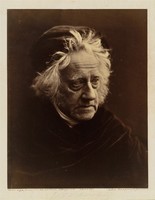 Sir John Herschel This image depicts "Sir John Herschel, Victorian England’s preeminent scientist, astronomer, and mathematician, considered the equal of Sir Isaac Newton. Herschel wrote to her in Calcutta of Henry Talbot’s invention of photography and sent her the first photographs she had ever seen. Of her 1867 portraits of Herschel, she wrote: “From my earliest girlhood I had loved and honoured him, and it was after a friendship of 31 years’ duration that the high task of giving his portrait to the nation was allotted to me.” Of the four exposures Cameron made in April 1867, Herschel preferred this one, which portrayed him, he thought, as an 'old Paterfamilias.'"
Sir John Herschel This image depicts "Sir John Herschel, Victorian England’s preeminent scientist, astronomer, and mathematician, considered the equal of Sir Isaac Newton. Herschel wrote to her in Calcutta of Henry Talbot’s invention of photography and sent her the first photographs she had ever seen. Of her 1867 portraits of Herschel, she wrote: “From my earliest girlhood I had loved and honoured him, and it was after a friendship of 31 years’ duration that the high task of giving his portrait to the nation was allotted to me.” Of the four exposures Cameron made in April 1867, Herschel preferred this one, which portrayed him, he thought, as an 'old Paterfamilias.'" -
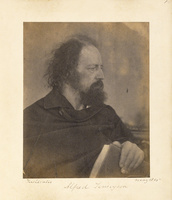 Alfred, Lord Tennyson This image depicts the renowned English poet, Alfred Lord Tennyson. In addition to Cameron's multiple portraits of Tennyson, the poet commissioned a series of images to accompany his collection of twelve narrative poems called Idylls of the King.
Alfred, Lord Tennyson This image depicts the renowned English poet, Alfred Lord Tennyson. In addition to Cameron's multiple portraits of Tennyson, the poet commissioned a series of images to accompany his collection of twelve narrative poems called Idylls of the King. -
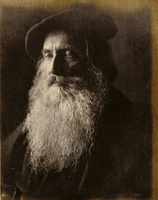 Henry Taylor This image depicts the poet and dramatist, Henry Taylor. Taylor was a frequent sitter for Cameron over the course of her career. In addition to multiple portraits, Taylor is featured in her Idylls of the King work for poet, Lord Tennyson.
Henry Taylor This image depicts the poet and dramatist, Henry Taylor. Taylor was a frequent sitter for Cameron over the course of her career. In addition to multiple portraits, Taylor is featured in her Idylls of the King work for poet, Lord Tennyson. -
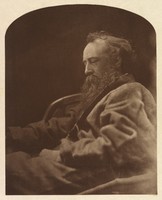 George Frederick Watts This portrait depicts the English sculptor and painter, George Frederick Watts. Cameron and Watts met in the Little Holland House, an artist salon run by the sister of Cameron's husband.
George Frederick Watts This portrait depicts the English sculptor and painter, George Frederick Watts. Cameron and Watts met in the Little Holland House, an artist salon run by the sister of Cameron's husband. -
 Gareth and Lynette “At the Poet Laureate Alfred, Lord Tennyson's suggestion, Julia Margaret Cameron created a series of illustrations for his epic poem Idylls of the King. " This image was created to accompany the second section of the Idylls entitled "Gareth and Lynette." It depicts Lynette looking upon Gareth as he sleeps.
Gareth and Lynette “At the Poet Laureate Alfred, Lord Tennyson's suggestion, Julia Margaret Cameron created a series of illustrations for his epic poem Idylls of the King. " This image was created to accompany the second section of the Idylls entitled "Gareth and Lynette." It depicts Lynette looking upon Gareth as he sleeps. -
 Queen Guinevere “At the Poet Laureate Alfred, Lord Tennyson's suggestion, Julia Margaret Cameron created a series of illustrations for his epic poem Idylls of the King. " This image was created to accompany the 10th section of the Idylls entitled "Guinevere." It depicts the figure of Queen Guinevere, wife of King Arthur who falls in love with Sir Lancelot.
Queen Guinevere “At the Poet Laureate Alfred, Lord Tennyson's suggestion, Julia Margaret Cameron created a series of illustrations for his epic poem Idylls of the King. " This image was created to accompany the 10th section of the Idylls entitled "Guinevere." It depicts the figure of Queen Guinevere, wife of King Arthur who falls in love with Sir Lancelot. -
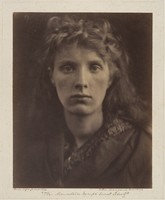 The Mountain Nymph Sweet Liberty This image depicts a female model as a mountain nymph named Sweet Liberty. The image takes its name from the poet John Milton's work entitled L'Allegro, a celebration of the pleasures of life.
The Mountain Nymph Sweet Liberty This image depicts a female model as a mountain nymph named Sweet Liberty. The image takes its name from the poet John Milton's work entitled L'Allegro, a celebration of the pleasures of life. -
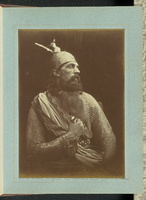 The Passing of King Arthur “At the Poet Laureate Alfred, Lord Tennyson's suggestion, Julia Margaret Cameron created a series of illustrations for his epic poem Idylls of the King. " This image was created to accompany the final section of the Idylls entitled "the Passing of King Arthur." It depicts the mythic leader in medieval chainmail armor and a helmet, holding tightly to a sword.
The Passing of King Arthur “At the Poet Laureate Alfred, Lord Tennyson's suggestion, Julia Margaret Cameron created a series of illustrations for his epic poem Idylls of the King. " This image was created to accompany the final section of the Idylls entitled "the Passing of King Arthur." It depicts the mythic leader in medieval chainmail armor and a helmet, holding tightly to a sword. -
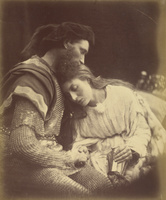 The Parting of Sir Lancelot and Queen Guinevere “At the Poet Laureate Alfred, Lord Tennyson's suggestion, Julia Margaret Cameron created a series of illustrations for his epic poem Idylls of the King. The images that Cameron created for the Idyllsare the most illustrative works she made; she took great care with the details of costumes and props to insure the photographs' faithfulness to his narrative. She employed a variety of people as models, going to great lengths to ensure the appropriateness of sitter to subject. This image depicts the final embrace of the tragic lovers before they are forever parted.”
The Parting of Sir Lancelot and Queen Guinevere “At the Poet Laureate Alfred, Lord Tennyson's suggestion, Julia Margaret Cameron created a series of illustrations for his epic poem Idylls of the King. The images that Cameron created for the Idyllsare the most illustrative works she made; she took great care with the details of costumes and props to insure the photographs' faithfulness to his narrative. She employed a variety of people as models, going to great lengths to ensure the appropriateness of sitter to subject. This image depicts the final embrace of the tragic lovers before they are forever parted.” -
 Ellen Terry at Age Sixteen "This contemplative portrait of Ellen Terry shows as a new bride during the Shakespearean actress's honeymoon stay at Freshwater on the Isle of Wight, where Cameron lived. Terry had married the portrait painter George Frederick Watts. Terry's forlorn expression and nervous gesture may be an actress's performance put on for the camera. Employing a non-fading print process used for commercially distributed pictures, Cameron's printer made multiple carbon prints available for purchase by Terry's and Cameron's fans."
Ellen Terry at Age Sixteen "This contemplative portrait of Ellen Terry shows as a new bride during the Shakespearean actress's honeymoon stay at Freshwater on the Isle of Wight, where Cameron lived. Terry had married the portrait painter George Frederick Watts. Terry's forlorn expression and nervous gesture may be an actress's performance put on for the camera. Employing a non-fading print process used for commercially distributed pictures, Cameron's printer made multiple carbon prints available for purchase by Terry's and Cameron's fans." -
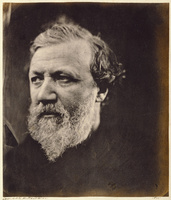 Robert Browning This is a portrait of the English poet and playwright, Robert Browning. It was taken at the Little Holland House, according to inscription on the mount, an artists' salon run by the sister of her husband.
Robert Browning This is a portrait of the English poet and playwright, Robert Browning. It was taken at the Little Holland House, according to inscription on the mount, an artists' salon run by the sister of her husband. -
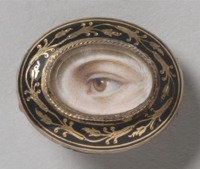 Portrait of a Left Eye - Philadelphia Museum of Art Watercolor on ivory. Dimensions: 5/16 x 1/2 inches (0.8 x 1.3 cm)
Portrait of a Left Eye - Philadelphia Museum of Art Watercolor on ivory. Dimensions: 5/16 x 1/2 inches (0.8 x 1.3 cm) -
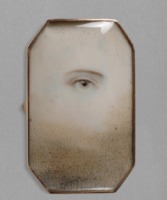 Portrait of a Right Eye - Philadelphia Museum of Art Watercolor on ivory, mounted on a ring. Dimensions: 1 1/8 x 11/16 inches (2.9 x 1.7 cm)
Portrait of a Right Eye - Philadelphia Museum of Art Watercolor on ivory, mounted on a ring. Dimensions: 1 1/8 x 11/16 inches (2.9 x 1.7 cm) -
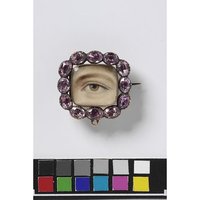 Eye Miniature - Victoria and Albert Museum Square frame edged with 12 pink stones. Brown iris. Close up of face.
Eye Miniature - Victoria and Albert Museum Square frame edged with 12 pink stones. Brown iris. Close up of face. -
 Eye Miniature - Victoria and Albert Museum Portrait miniature of an eye, probably male, medium brown in color, with fringe of red hair also visible.
Eye Miniature - Victoria and Albert Museum Portrait miniature of an eye, probably male, medium brown in color, with fringe of red hair also visible. -
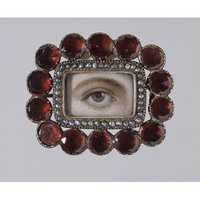 Eye Miniature - Victoria and Albert Museum Oblong frame set with 14 dark pink stones. Blue iris. Close up of face.
Eye Miniature - Victoria and Albert Museum Oblong frame set with 14 dark pink stones. Blue iris. Close up of face. -
 Portrait of a Right Eye - Philadelphia Museum of Art Watercolor on ivory Dimensions:Diameter: 3/4 inches (1.9 cm)
Portrait of a Right Eye - Philadelphia Museum of Art Watercolor on ivory Dimensions:Diameter: 3/4 inches (1.9 cm) -
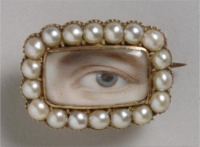 Portrait of a Left Eye - Philadelphia Museum of Art Watercolor on ivory Dimensions: 1/4 x 1/2 inches (0.6 x 1.3 cm)
Portrait of a Left Eye - Philadelphia Museum of Art Watercolor on ivory Dimensions: 1/4 x 1/2 inches (0.6 x 1.3 cm) -
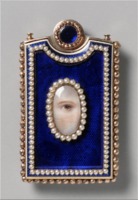 Memorandum Case with a Portrait of a Woman's Left Eye - Philadelphia Museum of Art
Memorandum case with an insert of seven ivory leaves and two pencils. Miniature: 1 5/16 x 9/16 inches (3.3 x 1.4 cm) Case: 3 7/8 x 3 3/16 inches (9.9 x 8.1 cm)
Memorandum Case with a Portrait of a Woman's Left Eye - Philadelphia Museum of Art
Memorandum case with an insert of seven ivory leaves and two pencils. Miniature: 1 5/16 x 9/16 inches (3.3 x 1.4 cm) Case: 3 7/8 x 3 3/16 inches (9.9 x 8.1 cm) -
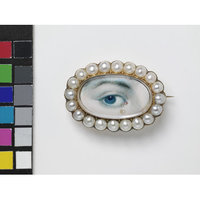 Eye Miniature - Victoria and Albert Museum Oval shaped frame set with 20 small pearls. Blue iris. Close up of face. Two diamond "tears".
Eye Miniature - Victoria and Albert Museum Oval shaped frame set with 20 small pearls. Blue iris. Close up of face. Two diamond "tears". -
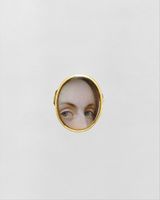 Lover's Eyes - The Metropolitan Museum of Art Watercolor on ivory painting Lock of human hair 1 X 3/4 in. (2.5 X 1.9 cm)
Lover's Eyes - The Metropolitan Museum of Art Watercolor on ivory painting Lock of human hair 1 X 3/4 in. (2.5 X 1.9 cm)